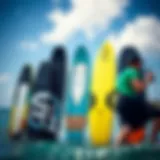Impact Vests: Essential Kiteboarding Safety Gear

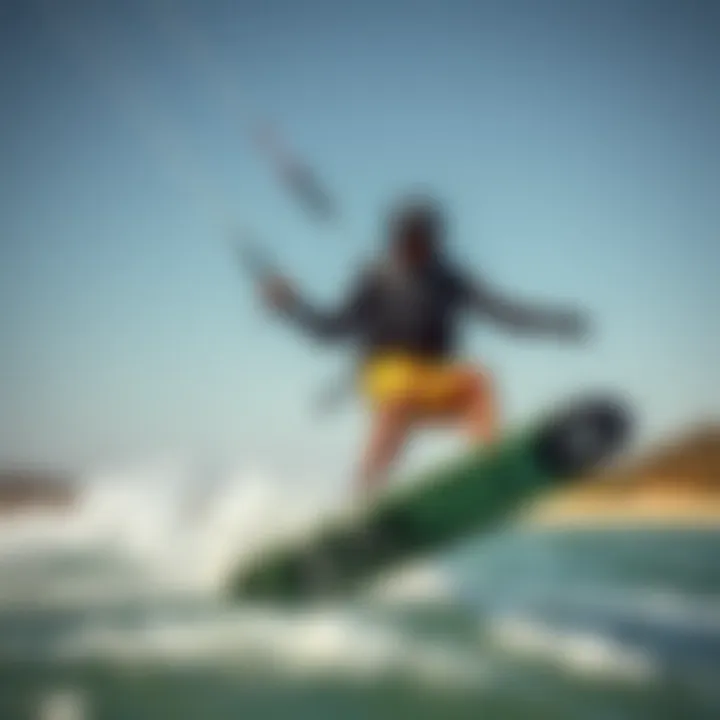
Intro
Kiteboarding, that exhilarating blend of wind and water, demands not just skill but also an unwavering commitment to safety. In this dance with the elements, your armor becomes pivotal. While many rely solely on traditional life jackets, impact vests are rapidly gaining traction as the go-to gear for kiteboarders. These specialized garments provide not just buoyancy, but also the critical padding needed to ward off injuries from unexpected falls and jumps.
This guide digs deep into the nuances of impact vests, painting a complete picture for both seasoned pros and those just beginning their kiteboarding journey. With insights from industry experts and insights into design innovation, the article sheds light on the balance between mobility and safety. Complex structures are woven into simple fabrics, and understanding this can greatly enhance your kiteboarding experience. So, strap on as we delve into the specifics, safety regulations, materials, and expert tips that turn impact vests from a mere accessory into an essential piece of equipment.
Gear Insights
Latest Gear Reviews
Choosing the right impact vest can feel like navigating a maze, especially with the myriad of options available. The best vests don’t just float; they keep you protected while allowing for free movement. Key examples include:
- O'Neill Impact Vest: Known for its superior flotation and flexibility, this vest utilizes a unique foam structure that keeps you buoyant while allowing for the fluidity needed for advanced maneuvers.
- Cabrinha Impact Vest: Building on a lightweight design, it combines ergonomic comfort with high-impact protection, offering a snug fit that feels almost like a second skin.
- ION Impact Vest: A favorite among professionals, it showcases an impressive blend of materials geared towards both performance enhancement and injury prevention.
Staying updated on the latest reviews is crucial. A visit to Reddit's r/kiteboarding or other forums can unveil user experiences that might not make it into formal reviews but provide real-life insights into the gear on the market.
Essential Gear for Beginners
For newcomers, the right starter kit goes beyond just a kite and board. An impact vest should top their list. The key aspects to focus on for beginners include:
- Size and Fit: An ill-fitting vest can hinder movement and ultimately your performance. Getting professionally measured can be a good first step.
- Material Quality: Opt for vests made from durable, flexible materials that offer both buoyancy and protection. Look for options with high-quality neoprene and foam.
- Additional Features: Vests with adjustable straps or or breathable fabric can make a significant difference in comfort, especially throughout long sessions on the water.
When diving into kiteboarding, it pays to invest in quality gear. A good impact vest can last years, providing not only safety but also confidence as you tackle new challenges on the waves.
"The right gear doesn't just protect you; it empowers your learning curve and unlocks your potential as a kiteboarder." - Professional Kiteboarder
Techniques and Tips
Note: As this section was not requested for the initial input, it will be omitted in this iteration. The final article can extend seamlessly from the gear insights to broader techniques and safety practices, should it be desired.
Maintaining a background knowledge of ongoing innovations and keeping safety in mind is critical as kiteboarding evolves. In the vast expanse of open waters and gusty winds, the impact vest transcends being mere equipment; it becomes a lifeline, literally and figuratively.
Prelude to Impact Vests
In the world of kiteboarding, where the wind and waves dictate the experience, safety is paramount. Enter the impact vest, a specialized piece of gear that serves dual purposes: providing buoyancy and offering protection against sudden jolts. These vests are not just fashion statements; they are essential for anyone serious about the sport. Whether you are a seasoned kiteboarder carving through the surf or a beginner navigating the shallows, understanding the significance of impact vests greatly enhances your approach to safety on the water.
Definition and Purpose
An impact vest is essentially a hybrid between a life jacket and a protective gear. It's designed to keep the wearer afloat while also cushioning against hard landings or crashes often encountered in kiteboarding. The buoyancy aids in keeping the rider stable on the water, while the interior padding absorbs shocks from falls. This might look like a simple vest, but inside, it’s crafted with layers of foam and specialized materials that ensure comfort and mobility alongside safety.
For kiteboarders, the primary purpose of an impact vest extends beyond just buoyancy. The right vest can significantly reduce the risk of injury during high-energy maneuvers, such as jumps and tricks. When you consider the fast pace and thrilling nature of the sport, having a vest that mitigates impact from falls becomes invaluable. Think of it as your safety net—your invisible guardian while you dance with nature.
Historical Context of Impact Vests in Water Sports
The evolution of impact vests in water sports, particularly kiteboarding, has been fascinating. Initially, kiteboarders relied solely on traditional life jackets. These vests, while they provided flotation, often limited movement and were cumbersome to wear during rigorous action. As the sport advanced and the tricks evolved, the demand for more performance-focused gear grew.
The late 1990s saw the introduction of soft-shell vests that combined buoyancy with impact resistance. This was a turning point. Riders began to experiment increasingly with higher jumps and acrobatics. The design shift sparked innovation in materials—manufacturers started using lightweight, flexible foams and durable outer shells. A good example of this evolution can be seen in vests from brands like Mystic and ION, which have pioneered such shifts in design and material use.
Key Features of Impact Vests
When kiteboarding, having the right safety equipment can make all the difference. The distinct features of impact vests not only guarantee safety but also enhance performance on the water. Understanding these key features is vital for any kiteboarder, whether you're just starting or already have a seasoned experience.
Material Composition
Material composition is a foundational aspect of any impact vest, influencing its performance and user experience. Key materials contribute to both safety and comfort, enabling kiteboarders to perform at their best while feeling secure.
Neoprene
Neoprene stands out as a favorite choice for impact vests. Its flexibility and insulating properties make it well-suited for water sports.
- Water Resistance: Neoprene is inherently water-resistant, helping keep the vest lightweight even when wet.
- Comfort: The material offers a snug fit without restricting movement, crucial for maneuverability on the water.
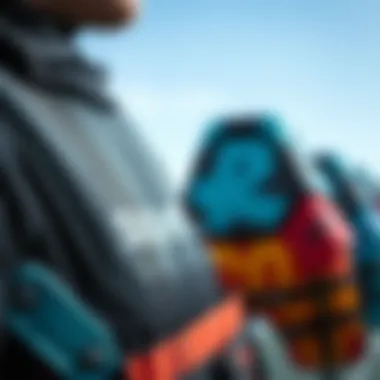
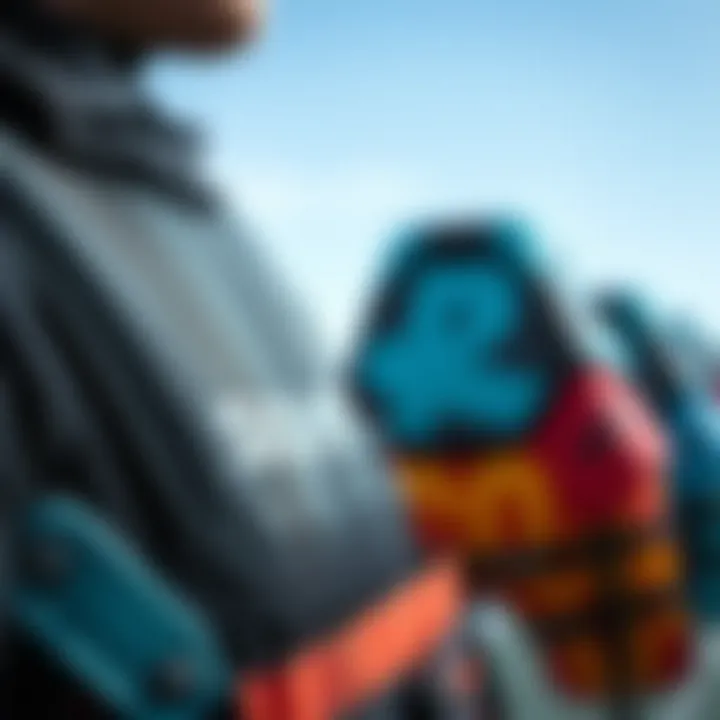
A unique feature of neoprene is its ability to withstand extreme temperatures, ensuring that users remain comfortable in varying conditions. However, one should note that while neoprene provides warmth, it can sometimes trap body heat, which may not be ideal in hot climates.
Foam Padding
Foam padding plays a crucial role in absorbing impacts, making it a necessity in any impact vest. This padding serves to cushion the body during falls or collisions with the water.
- Shock Absorption: The padding mitigates the force of impact, which is essential for minimizing injuries.
- Lightweight: Many types of foam are incredibly lightweight, ensuring that it does not hinder performance while riding.
A distinct advantage of foam padding is its ability to retain shape after multiple impacts. Yet, some types of foam may not be as durable, and excessive wear may reduce their effectiveness.
Outer Shell Durability
The outer shell of an impact vest is what stands between your body and external hazards. Its durability is non-negotiable for any kiteboarder.
- Tear Resistance: High-quality outer shells resist tearing and abrasion, which are common when navigating through waves and rough conditions.
- UV Protection: Many modern materials offer protection against UV rays, which helps prolong the vest's lifespan.
The robustness of the outer shell is its standout feature, protecting critical areas of the body from cuts and scrapes. Yet, materials used must be balanced with weight; a very heavy outer shell might limit buoyancy and movement.
Buoyancy and Floatation
In the world of water sports, buoyancy can be the difference between safety and disaster. Impact vests are designed to aid in flotation without compromising movement. They often feature strategically placed floatation pads that indicate how buoyant the vest will be during use. This aspect is important for beginners needing that extra help while learning.
Size and Fit Considerations
The effectiveness of an impact vest hinges significantly on its size and fit. An improperly fitting vest can lead to discomfort or, worse, insufficient protection. When considering a vest, factors such as adjustable straps and body shape should be taken into account. Proper fit ensures buoyancy, protection, and freedom of movement, all of which are essential for a successful kiteboarding experience.
A snug and secure fit is as important as the materials used, impacting overall performance and safety on the water.
While diving into the details about each feature of impact vests, it's evident that each piece plays a significant role in the overall performance and safety of kiteboarders. By understanding these key features, enthusiasts can make informed decisions about the right gear for their next adventure.
Safety Regulations and Standards
When it comes to kiteboarding, safety doesn’t just take a backseat; it should be the driver. This section digs into the vital role that safety regulations and standards play in ensuring that impact vests not only protect users but also enhance their performance on the water. Compliance with these regulations is crucial, as it dictates the reliability and effectiveness of the gear being used regardless of whether one is a weekend adventurer or a seasoned pro.
International Safety Standards for Water Sports Equipment
Navigating through the world of water sports, one often hears about the regulations that keep riders safe. International standards, such as those established by organizations like ISO (International Organization for Standardization), really set the groundwork. For impact vests, it means that they need to meet criteria for buoyancy, durability, and impact resistance.
- Testing Requirements: These standards require rigorous testing under various conditions to determine how well a vest performs when faced with actual scenarios on the water. This involves simulations of impacts from different angles and at varying speeds.
- Material Compliance: The materials used in making the vests are also scrutinized. Specific requirements dictate that these materials preserve their integrity even after repeated use in saltwater and sunlight, which can be taxing.
Having vests conform to these standards not only protects the wearer but also fosters peace of mind for instructors and fellow riders. Think of it as having a trustworthy safety net; one that doesn’t fray at the edges when the pressure mounts.
"Safety regulations are like the rules of the road; they protect lives while allowing us to enjoy the ride."
Certification Processes for Impact Vests
Once the standards are set, the next step is certification, a process that ensures each impact vest lives up to its promises. These certification processes play a pivotal role in the credibility of the product. Here’s what one should consider:
- Third-party Verification: Many companies turn to independent testing agencies that are recognized globally. This helps ensure that claims made by manufacturers about their products hold water—quite literally.
- Periodic Re-evaluation: Materials and technology evolve, and so do testing protocols. Approved impact vests are subjected to periodic re-evaluation to ensure they still meet current standards.
For a kiteboarder, knowing that their impact vest has been certified not only assures them of its protective capabilities but also stands as a testament to a manufacturer’s commitment to safety.
By understanding these regulations and processes, kiteboarders can make informed choices about their gear and equip themselves with vests that have been thoroughly vetted for safety and performance.
Technical Aspects of Impact Resistance
Understanding the technical aspects of impact resistance in impact vests is crucial for kiteboarders and water sports enthusiasts. These features determine not only how well a vest protects against falls and collisions but also how it affects user performance in the water. The right blend of safety and functionality can make or break an adventure on the waves.
One of the primary benefits of impact resistance is its capacity to absorb shock during sudden impacts. Without adequate protection, kiteboarders face the risk of serious injuries ranging from bruises to fractures. This reality underscores the need for robust designs that integrate advanced technologies aimed at minimizing the damage incurred during crashes.
A key consideration when examining these technical features is the balance between protection and mobility. A vest that's too bulky may hinder a rider's movement, while a too-light vest might compromise safety. Hence, finding that sweet spot is essential. Let's dive deeper into the specific elements that influence impact resistance.
Impact Absorption Technologies

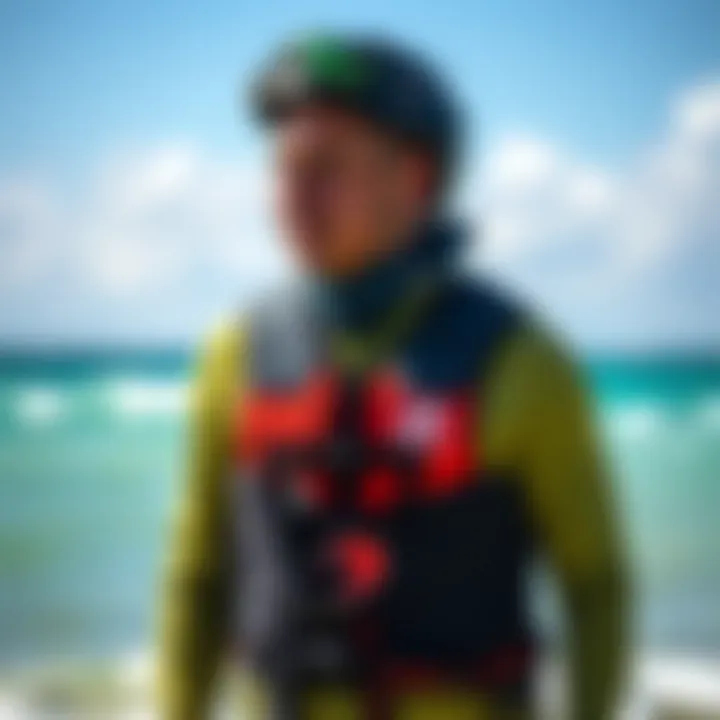
Innovations in impact absorption technologies have revolutionized the safety capabilities of impact vests. Various materials and methods are employed to ensure maximum protection. Here are some of the most significant types available today:
- Closed-cell Foam: Often used because of its high impact resistance and buoyancy, closed-cell foam also retains minimal water, thereby enhancing its effectiveness.
- Impact Gel: This is becoming increasingly popular in design due to its capacity to dissipate energy from impacts. The gel responds to high impact with a stiffening effect, providing superior protection when it's most needed.
- Layered Construction: Some manufacturers utilize multiple layers of different materials to achieve an optimal compromise between flexibility and impact resistance. Each layer serves its own purpose, whether it’s buoyancy, comfort, or impact mitigation.
The incorporation of these technologies not only enhances protection but also improves the overall rider experience. Riders can feel more confident taking risks, knowing they have reliable equipment to back them up. However, selecting the right technology based on individual needs and riding style remains vital.
Testing Methods for Impact Vests
Once a vest is constructed, rigorous testing is necessary to validate its effectiveness in protecting users. Testing methods vary widely but generally involve standardized procedures to evaluate both impact and buoyancy. Here are some key testing processes employed:
- Drop Tests: This method assesses how well a vest can handle sudden shocks from various heights and surfaces. Often, a drop is simulated using a weighting scale to replicate realistic impacts encountered on the water.
- Compression Tests: In these tests, vests are subjected to compressive forces to gauge how well they retain integrity under pressure. The results can highlight whether the materials can withstand prolonged use.
- Floatation Testing: This is another essential measure to ensure safety. A vest must not only protect against impacts but also keep the wearer afloat in case of an unforeseen incident.
"Proper testing is not just about meeting standards; it’s about ensuring that every rider can trust their gear to keep them safe while they pursue their passion on the water."
By employing these testing methods, manufacturers can confidently declare their products reliable for kiteboarders of all experience levels. With continuous advancements in materials and methods, riders can expect even greater levels of protection without sacrificing mobility.
User Perspectives: Analyzing Real Experiences
Understanding user perspectives regarding impact vests in kiteboarding provides invaluable insights that transcend standard product specifications. Personal experiences often reveal how a piece of gear performs under pressure and enhances the thrill of the ride. This section delves into the individual testimonies of kiteboarders, shedding light on how impact vests intertwine personal safety with performance enhancement in real-world scenarios.
Interviews with Seasoned Kiteboarders
Interviews with experienced kiteboarders serve as a rich source of information that goes beyond basic advice or manufacturer claims. These athletes, who have spent years honing their craft, can articulate the nuanced benefits that impact vests offer in dynamic conditions.
One seasoned kiteboarder shared his perspective on how proper fit significantly influences performance. He noted, "It’s not just about wearing any vest; it’s like finding that sweet spot between feeling secure and being able to move freely. If it’s too tight, you can’t maneuver, and if it’s too loose, well, it's just not safe."
Another common insight highlighted the importance of materials used in the vests. For instance, a rider mentioned that the neoprene used in her vest was essential for both comfort and buoyancy. She stated, "I've tried vests that felt like a brick wall when I fell. This one allows me to get back on my board quickly, which is crucial when you’re out there in choppy waters."
These accounts demonstrate that seasoned kiteboarders prioritize function and comfort in their gear. Knowing how a product performs in real settings can influence new riders’ choices, enabling them to pick equipment that meets their specific needs rather than just following trends.
"The right impact vest does more than offer protection; it enhances the entire riding experience."
A seasoned kiteboarder
Community Feedback on Various Brands
Community feedback on impact vests adds another layer to understanding their effectiveness. Online forums and social media platforms, like Reddit and kiteboarding groups on Facebook, have become comfortable spaces for kiteboarders to share thoughts on various brands.
Many users point to specific brands as their go-to options, often explaining why one might be better than another under certain conditions. For example, a user review on a popular kiteboarding forum praised the O'Neill Reactor Vest for its lightweight design yet robust protection. They commented, "It’s like wearing a second skin; I barely notice it when riding. Plus, the impact absorption is on point for those unexpected wipes out!"
Conversely, some riders have expressed disappointment with vests from other brands. One Kiteboarder remarked about a particular product: "I couldn't find my rhythm with that vest. It felt bulky and restricted my movements. Safety is important, but so is being able to ride without feeling like I’m strapped with weights."
Such feedback serves not just as reviews but also as cautionary tales. New riders or those looking to upgrade their gear can glean advice from these communal experiences, ensuring they choose wisely based on feedback from fellow enthusiasts.
Comparative Analysis: Different Brands of Impact Vests
Understanding the landscape of impact vests is crucial for every kiteboarder looking to find their optimal balance between safety and performance. With numerous brands out there offering various models, making an informed decision becomes quite the task. The comparative analysis of high-end versus budget options sheds light on the factors that differentiate these products, allowing you to gauge their value critically.
High-End Vs Budget Options
When it comes to selecting an impact vest, one is often faced with the options of high-end and budget offerings. Each category has its own appeal, but the choice hinges on several factors.
- Price Point: High-end vests typically come at a premium, reflective of advanced materials and technology. These vests are specially designed ensuring top-notch impact absorption and a superior fit. Budget options, while economically friendly, may not provide the same level of protection or comfort, compromising slightly on quality.
- Material Quality: With high-end brands like Ion, Mystic, and O'Neill, you often find materials that offer durability, flexibility, and superior buoyancy. In contrast, budget models may utilize less robust materials that serve their purpose adequately but may not withstand rigorous use over time.
- Design and Comfort: Well-tailored high-end vests feature ergonomic designs that hug the body, offering full range of motion while remaining comfortable. Budget options might be bulkier, resulting in restricted movement, which can be a deal-breaker when you need to execute intricate maneuvers on the water.
- Warranty and Customer Service: Premium brands usually offer extended warranties and better customer service. It’s not uncommon for high-end vests to come with a satisfaction guarantee, where brands stand by their product. In the budget arena, such reassurances may be few and far between.
Performance Comparison
When looking at performance, it’s vital to consider how different brands and models stack up against one another across key metrics. Evaluating performance can influence your choice significantly.
- Impact Absorption: One of the most critical aspects to assess is how well a vest absorbs impact. Brands like Mystic and NP have been lauded for their high-impact foam and innovative designs. On the flip side, some budget brands may not adhere to the same level of impact resistance, potentially leaving users vulnerable.
- Buoyancy: Brands also differ in buoyancy characteristics. A vest that effectively keeps a user afloat during a fall can make all the difference in a high-stakes environment. High-end options often rely on specialized buoyancy aids, versus lower-cost alternatives that may not provide the same level of support.
- Mobility: Freestyle kiteboarding requires a lot of agile movements. Here, the cut and flexibility of the vest become essential. Some brands might even integrate stretch panels to enhance mobility, which is often a distinguishing factor when comparing performance.
- User Endorsements: Feedback from real users can often be the telling factor. For example, seasoned kiteboarders might favor certain brands for their reliability under various conditions, which can inform new users about what to expect in real-world scenarios.
"The right impact vest not only protects; it liberates your movements on the water, allowing you to push your limits while assuring safety."
By evaluating the performance characteristics of the impact vests through direct comparisons, potential buyers can make more educated decisions tailored to their specific needs. Performance is where brands truly begin to distinguish themselves, and recognizing these differences can enhance both safety and enjoyment during kiteboarding adventures.
Refer to Wikipedia for more information about kiteboarding equipment.
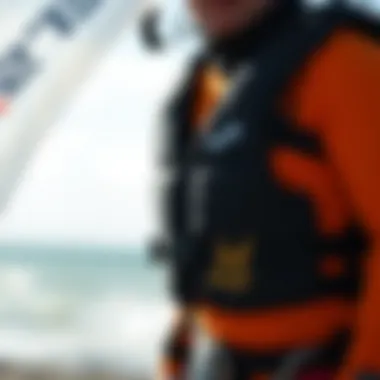
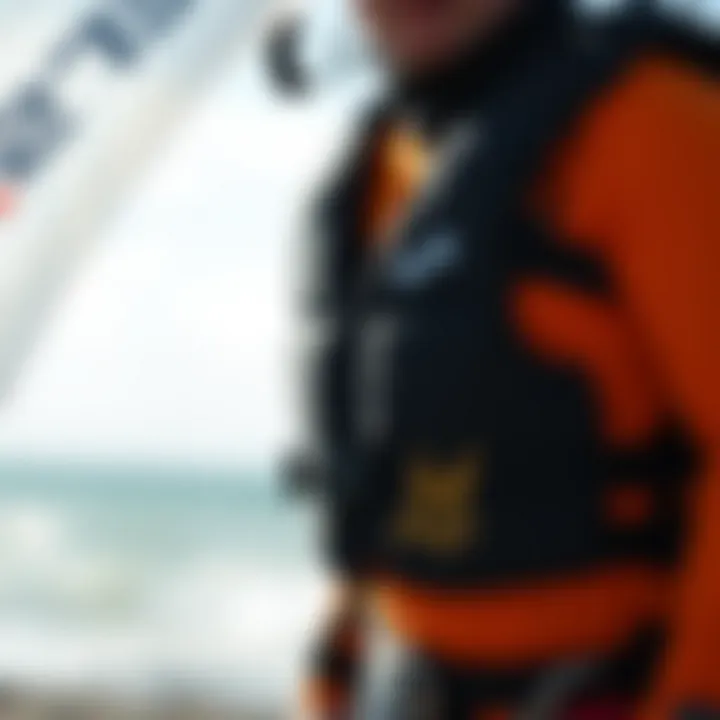
Best Practices for Maintenance and Care
Ensuring your impact vest remains in top shape isn’t just about appearances; it directly influences your safety and performance on the water. Given the extreme conditions kiteboarders often face, adopting effective maintenance and care practices for your vest can extend its lifespan and enhance its functionality. Proper upkeep minimizes wear and tear and can also bolster your buoyancy, making it an essential component of your overall kiteboarding experience. So, let’s dive into the nitty-gritty details of what it takes to keep your impact vest ready for action.
Cleaning Procedures for Longevity
Keeping your impact vest clean is more than just a matter of aesthetics—it helps maintain the materials' integrity. Water sports often involve exposure to saltwater, sand, and sometimes even debris that can compromise the vest's protective features.
Here are some practical cleaning procedures to follow:
- Rinse Immediately: After a kiteboarding session, rinse your vest in fresh water. This step washes away salt, sand, and other substances that could cause degradation over time.
- Gentle Hand Wash: If your vest needs a deeper clean, use a mild detergent and lukewarm water. Gently scrub with your hands, avoiding harsh brushes or aggressive scrubbing that could damage the outer layer.
- Air Dry: Never toss your vest in the dryer or leave it in direct sunlight for prolonged periods. Instead, hang it in a shaded area; this prevents fading and material weakness.
By taking the time to clean your vest properly, you're investing in its longevity and, ultimately, your safety while kiteboarding.
Storage Tips to Prevent Damage
Once you've cleaned your impact vest, storing it correctly is equally important for ensuring its durability. Improper storage can lead to various issues, including mold growth, warping, and material degradation. Here’s how to store it mindfully:
- Flat or Hanging Storage: Avoid folding your vest, as this can create creases that weaken the fabric. It's best to hang it on a wide hanger or lay it flat in a cool, dry place.
- Avoid Direct Sunlight: Excessive sun exposure can fade colors and break down materials over time. Store your vest in a closet or a shaded area, away from direct rays.
- Keep It Dry: Moisture can encourage mold and mildew. Ensure the vest is completely dry before you put it away, and consider placing a moisture-absorbing product in the storage area for an extra layer of protection.
By implementing these best practices, you ensure that your impact vest remains not only functional but also an effective safety tool during your kiteboarding adventures. Remember, good care is the cornerstone of safe and enjoyable rides.
In summary, regular cleaning and proper storage can significantly determine the lifespan and performance of your impact vest. Take these steps to heart, and your gear will repay you with reliable service when you hit the waves.
Impact Vests and Environmental Considerations
As environmental consciousness grows, the kiteboarding community increasingly acknowledges its responsibility regarding the ecological footprint of sporting equipment like impact vests. These essential safety devices, designed to protect riders, are also scrutinized for their environmental implications. Understanding the relationship between impact vests and environmental considerations becomes paramount, not just for individual riders but for the sustainability of the sport itself.
Sustainable Materials in Manufacture
Impact vests are gradually shifting towards using sustainable materials in their production. Traditionally, many vests have been made from synthetic materials like neoprene and nylon, which, while effective in terms of safety and performance, often rely on non-renewable resources. Neoprene, in particular, poses significant environmental challenges because its production involves harmful chemicals and processes that contribute to pollution.
Today, some companies are exploring alternatives like biodegradable foams and recycled polymers. For example, using recycled materials for the vest’s outer layer not only mitigates the impact on landfills but also reduces the demand for virgin materials, thus conserving resources. Some brands even prioritize natural components, integrating fabrics derived from organic sources or natural rubber, which tend to have a lesser environmental impact.
Such innovations are not just marketing ploys but vital steps toward producing gear that aligns with responsible kiteboarding practices. When opting for an impact vest, look for brands that proudly highlight their use of sustainable materials; it’s a small step that can lead to larger changes across the industry.
Impact of Waste Dangers in Water Sports
While enjoying the thrill of kiteboarding, enthusiasts must also consider the impact of waste dangers associated with the sport. In many instances, the disposal of damaged or outdated impact vests creates unmistakable challenges in terms of waste management. If these products are not disposed of properly, they can contribute to pollution in oceans and waterways. The accumulation of plastic pollution poses severe threats not only to marine life but also to the overall ecosystem.
The kiteboarding community’s responsibility extends to proper care and disposal of impact vests. Breaking the cycle of waste starts at the consumer level—by repurposing or recycling gear instead of discarding it, individuals can help reduce the amount of waste that enters the water.
Collaboration with organizations focusing on ecological sustainability can provide kiteboarders with resources about safe disposal and recycling options. Participating in community cleanup efforts can also raise awareness about the implications of improper waste in our waters. Through collective action and awareness, the impact of waste associated with water sports can be significantly diminished, supporting a cleaner environment.
"If we don't take care of our oceans, our oceans won't take care of us."
It’s essential to not only invest in good quality, sustainable impact vests but also to commit to a lifestyle that emphasizes respect for the environment. Through mindful choices regarding gear and its ultimate fate, the kiteboarding community can wave goodbye to excessive waste, paving the way for a cleaner and more sustainable future.
The Future of Impact Vests in Kiteboarding
As the kiteboarding landscape continues to evolve, the future of impact vests is poised to play an instrumental role in enhancing safety and performance. These vests, more than just accessories, are becoming a pivotal part of a kiteboarder's gear, particularly with increasing participation in the sport. By emphasizing both design advancements and regulatory considerations, we can understand the dynamism in the development of these safety devices.
One cannot deny the rising interest in kiteboarding, as new enthusiasts become part of the community. In this light, the impact vest transforms into an essential piece of equipment, not only for seasoned riders but also for beginners. This section aims to unravel the exciting directions this equipment is taking, underscoring the benefits and the considerations brought about by these changes.
Innovations in Design and Functionality
The design of impact vests has witnessed significant innovation. In the past, these vests prioritized buoyancy over comfort and flexibility. However, the latest advancements have seen manufacturers balance these factors much more efficiently.
- Enhanced Materials: New materials are being developed that provide better impact absorption while remaining lightweight. For instance, vests now use advanced foams and composite fabrics that offer increased cushioning without sacrificing mobility.
- Ergonomic Design: The shift towards a more ergonomic fit means that vests are now tailored to move with the body, allowing for a greater range of motion. This is crucial when kiteboarding, where every second counts, and mobility can directly affect performance.
- Integrated Safety Features: Innovations such as buoyancy aids and quick-release systems are also becoming standard. These features not only enhance safety but also allow for quick adjustments during use, which is vital during challenging wind conditions.
"The right impact vest can mean the difference between a bad fall and a safe landing, adapting to the movements of the water and wind." – Industry Expert
Incorporating these elements ensures that every kiteboarder can focus on their ride without the fear of compromised safety. As technology advances, we can expect to see further tailored adjustments to accommodate individual riding styles, promoting a more customized experience.
Potential Regulatory Changes
As our understanding of safety evolves, so too does the regulatory framework surrounding impact vests. Recent discussions within regulatory bodies indicate a shift toward stricter standards, aiming to enhance user safety further.
- Increased Testing Protocols: New testing methods are being developed to ensure that impact vests comply with enhanced safety standards. These protocols are likely to include more rigorous assessments on durability and impact resistance in various conditions, making sure that manufacturers meet a higher bar.
- Mandatory Certification: The future might see an increase in certifying bodies evaluating the toughness of equipment before it hits the market. This means kiteboarders can expect a new level of confidence in their gear, knowing it meets standardized safety requirements.
- Focus on Environmental Sustainability: Alongside heightened safety, regulatory changes might also consider environmental factors. With a growing awareness of ecological issues, impact vests may require materials that have less impact on marine environments, encouraging more sustainable practices across the industry.
As industry professionals navigate the intricacies of compliance and safety advancements, they also look towards creating a culture of safety-first in kiteboarding. In this context, the future of impact vests will not just aim for better technology but will also consider the broader implications of their presence in water sports.
